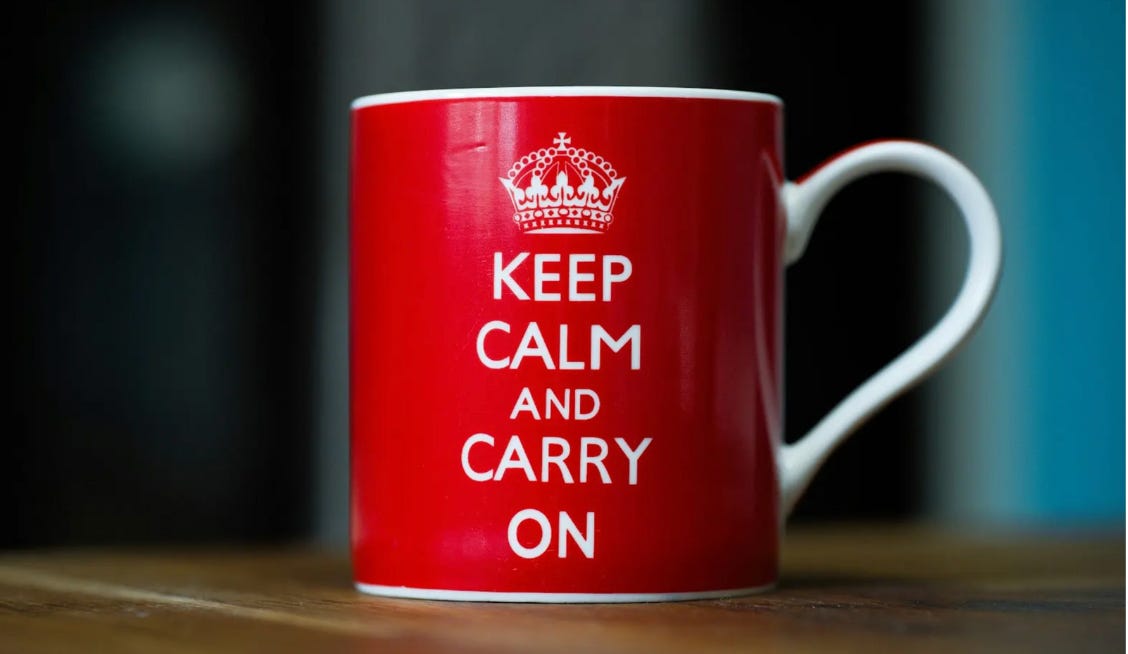Keep Calm and Carry On: The Resilience Myth in Schools
A Provocations Article from Tom Brown
In the UK, one of the most familiar slogans—plastered across mugs, tea towels, and tourist shops—is Keep Calm and Carry On.
The original poster was created in 1939 to boost morale ahead of World War II. In that context—amid threats to national sovereignty and collective sacrifice—the slogan made a kind of sense. But used today, it romanticises that wartime spirit, as though enduring hardship quietly were a moral good in itself.
It’s become shorthand for what many see as a defining feature of British character: that in times of difficulty, we keep a stiff upper lip, avoid making a fuss, and carry on as usual.
As Owen Hatherley, author of The Ministry of Nostalgia, writes:
“The poster isn’t just a case of the return of the repressed, it is rather the return of repression itself. It is a nostalgia for the state of being repressed – solid, stoic, public spirited.”
This ethos of stoicism and quiet compliance still runs deep in England. Our national defaults are risk aversion, deference, and the avoidance of conflict or discomfort. We are, in many ways, a deeply repressed nation.
And this same ethos is baked into our education system—one of Britain’s most enduring and influential colonial exports. While we often hear about the education system’s industrial roots, we must also recognise its foundation in Victorian values: obedience, decorum, inhibition, social control, and the preservation of hierarchy. It wasn’t just designed to educate—it was designed to condition and control. To keep calm and carry on.
Keep Calm and Show Grit
I’m beginning to feel the same kind of distaste for the words grit and resilience, and the way they’ve been weaponised in education.
Angela Duckworth popularised the concept of grit, defining it as “perseverance and passion for long-term goals.” In her research, grit isn’t just about enduring hardship—it’s about sustained effort and deep interest over time. It’s about working hard toward something that matters to you.
But in schools, this idea is often reduced to compliance. Grit becomes a way to praise students who show up, stay quiet, and tolerate discomfort—regardless of whether they feel safe, engaged, or valued.
A recent comment from Education Secretary Bridget Phillipson illustrates this. Writing in The Telegraph about the mental health crisis in schools, she called for “much-needed grit among the next generation,” connecting this lack of grit in our youth to a national “worklessness crisis.”
But grit can’t be mandated. We can’t foster resilience through forced attendance and reactive mental health support. Record levels of absence, rising school exclusions, and the youth mental health crisis are the symptoms of systemic failure, not the cause. The real issue? Many young people find no meaning or joy in school. English secondary students report some of the lowest levels of school engagement globally.
Steve Chalke, CEO of Oasis Trust, responded to Phillipson’s comments by saying:
“If you are bored with the curriculum and bored with school, you’re not going to attend…Schools should be magnetic. There are lots of things in life that are important, and lots of things that are important that we never quite get round to. But we do things that are magnetic, that pull us in.”
You can’t just keep calm and carry on your way to resilience. Grit isn’t passive compliance. It’s active engagement in something purposeful.
Keep Calm and Attend School
Of course, the UK government has its own poster campaign. The poster above is from a campaign launched by the UK government at the beginning of last year. In other posters from the series, parents are reminded to send their children to school even if they have a “sniffle” or “stomach ache” because they’ll be skipping along and smiling by lunchtime. This campaign was designed in response to what’s being called a national “attendance crisis,” with 1 in 4 secondary school students now persistently absent. In response, the government also increased fines for families.
Improving attendance has become the latest obsession in UK education. It’s trackable, measurable, and politically useful. But for many families, it’s a hollow metric. I’ve spoken to parents who’ve begged schools for support with bullying or mental health, only to feel that attendance is all anyone cares about.
At a local secondary school, the mental health lead told me that they’re currently overwhelmed by the number of EBSAs—Emotionally Based School Avoiders—they have on site. The term alone is revealing: “school avoiders” is a label used in the UK to describe students whose attendance is compromised by factors such as special educational needs, physical or mental illness, bullying, or trauma.
This school has a significant number of students who are physically present at school—often because their families fear fines—but who are entirely unable to participate in school life. They are sequestered in the library, front office, or detention all day. They’re not learning, but they are attending.
This is a clear indication of a system that is broken.
Keep Calm and Pretend It’s Fine
The Keep Calm and Carry On effect isn’t just in policy—it’s in the way many parents talk about school. In conversation after conversation, I hear the same refrain: not that school is joyful or inspiring, just that it’s “fine”. There’s a weary acceptance. A sense that this is just how things are.
But I work with many families whose children are not fine. Children with EHCPs (Education, Health and Care Plans). Children labelled as EBSAs. Children with ASD, ADHD, PDA. All the children reduced to acronyms. As of January 2024, over 1.7 million pupils in England were identified with SEND—18% of all students. The number with EHCPs has more than doubled since 2015. Many of these children are leaving school entirely, pushed into home education or alternative provision.
And even for those who stay, “fine” often means surviving, not thriving. One of the bleakest things I hear from parents is:
“Year 7 was really hard. I had to force her out of the house crying every day. But she’s doing much better now in Year 8.”
By “better,” they mean their child is “fine.” They’ve adjusted. Made friends. Learned to cope. But what’s the cost of that adjustment? Too often, we assume that endurance builds character. That struggling through school is a rite of passage. We all went through it. It didn’t kill us.
But conformity is not resilience.
Never before have adolescents been expected to navigate such a perfect storm of academic pressures, social complexity, institutional inflexibility, and global crisis—and still carry on as though it’s normal. In 2023, NHS data showed that 1 in 5 children aged 8–16 had a probable mental disorder. Nearly 30% of secondary students report avoiding school due to anxiety.
Real resilience doesn’t look like coping in silence. I would argue that true resilience exists in non-conformity. It’s not about coping with harmful conditions, it’s about refusing to accept them. It’s about protest, resistance, and questioning systems that don’t serve us. Not keeping calm and carrying on—but refusing to carry on like this.
There’s a bizarre narrative that young people today are too fragile. The idea persists that:
“The younger generation is just less mentally tough than ours. They just need to get on with it.”
But in my mind, real fragility is the inability to tolerate change. The inability to sit with discomfort or rethink our assumptions.
It takes courage:
— to be the teenager who opts out
— the family that chooses a different path
— the educator who dares to try something new
Keep Calm and Follow the Child
Dr. Montessori saw this coming. In From Childhood to Adolescence (1948), she wrote:
“Secondary schools as they are at present constituted do not concern themselves with anything but the preparation for a career, as if the social conditions of the time were peaceful and secure…
Young people… are compelled to study as a ‘duty’ or ‘necessity’. They are not working with interest nor any definite aims that could be immediately fulfilled and that give them satisfaction and a renewed interest in continuous effort…
They are still subjected to the petty threat of ‘bad marks’ with which teachers weigh up the work of boys and girls… And on these marks the future of the student depends.
So study becomes a heavy and crushing load that burdens the young life instead of being felt as the privilege of initiation to the knowledge that is the pride of our civilization.”
Her critique still holds. We’ve built a system obsessed with outcomes, rankings, and resilience—but stripped of meaning, purpose, and joy. We tell children that grit will get them through, but we rarely ask whether there’s anything worth persevering for.
In contrast, Montessori adolescent education focuses on valorization—the development of self- worth through meaningful work. It’s not about surviving school or chasing praise; it’s about discovering your own value by doing something that matters, especially in service to others. This is what real grit looks like: sustained effort toward a purposeful goal.
Montessori is one path—but it’s not the only one. Across the UK and beyond, families, educators, and communities are building alternatives: forest schools, democratic schools, self-directed learning environments. What unites them is a refusal to treat children as problems to be fixed. They don’t demand children conform to systems. They demand systems conform to children.
Keep Calm and Stay Radical
Montessori and other progressive schools are not immune to the Keep Calm and Carry On effect. The same pressures creep in. “Peace” becomes quiet compliance. A “normalized” classroom becomes one where children sit still and don’t cause trouble. I highly recommend listening to Justin Tosco and Andrew Faulstich’s discussion “Is Peace Problematic?” on the Breaking the Paradigm podcast for more on this idea.
If we are to remain truly radical, we must resist this slide into respectability. We must prioritise student voice, community responsibility, and meaningful work. We must be willing to look ourselves in the mirror and ask: are we upholding liberation, or just enforcing a softer kind of control?
Yes, this work takes grit and resilience. But not the kind that simply carries on the status quo. We need schools that feel alive—where young people are seen, heard, and valued. Where resilience means agency. Where learning is not a burden, but a joy.
We can’t just keep calm and carry on.
Tom Brown is an AMI-trained guide specializing in both elementary and adolescent education, with an M.Ed. in Montessori Education and over a decade of experience teaching in public and private Montessori settings. He is the founder of Marigold Montessori, where he currently serves as an educational consultant, presenter, and coach. He leads the secondary programme at Lumiar UK, the first school of its kind outside Brazil, where he champions student-led, project-based learning. His work is driven by a deep commitment to social justice, ABAR (Anti-Bias, Anti-Racism) education, youth advocacy, and child-centered learning.
Thanks Tom for your contribution to Provocations!
References:
Duckworth, A. L., Peterson, C., Matthews, M. D., & Kelly, D. R. (2007). Grit: Perseverance and passion for long-term goals. Journal of Personality and Social Psychology, 92(6), 1087–1101.
Phillipson, B., & Streeting, W. (2025, May 16). Children to be taught to show some ‘grit’ to tackle mental‑health crisis. The Telegraph.
UCL News. (2025, April). Secondary pupils in England among the least emotionally engaged in school. University College London.
Sec‑Ed. (2023). School attendance crisis: One in four secondary students persistently absent. Sec‑Ed.
NHS England. (2023, November 21). Mental health of children and young people in England, 2023 (Wave 4 follow-up).
Montessori, M. (1948). From Childhood to Adolescence.
Tosco, J., & Faulstich, A. (2025, May 25). "Is peace problematic?" Breaking the Paradigm podcast.
UK Department for Education. (2024, January). Special educational needs in England: Academic year 2023/24.
Chalke, S. (2025, May). “If you are bored with the curriculum… Schools should be magnetic.” [Comment on Phillipson article]. Retrieved from https://www.facebook.com/watch/?v=3784513118505676






